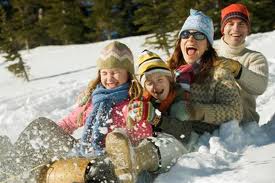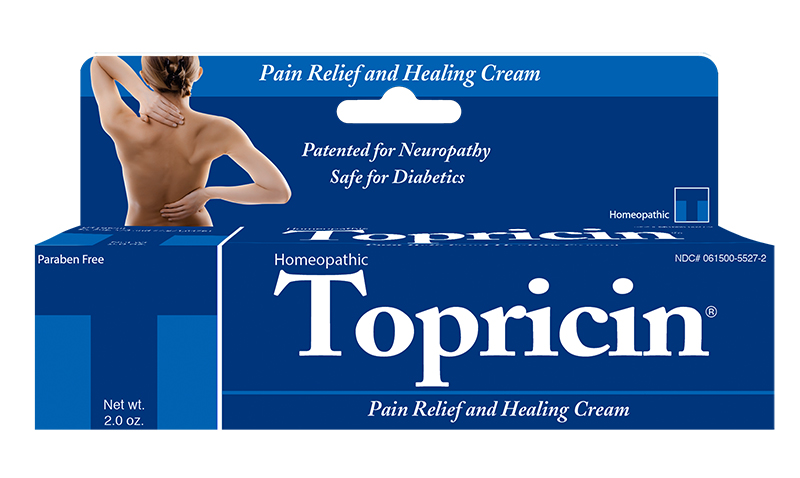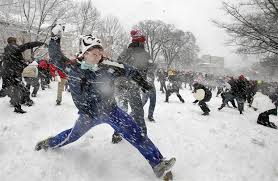Winter Survival: Cold Weather Health Tips from Topical BioMedics, Inc.
Rhinebeck, NY (PRWEB) January 24, 2014 -- North America has been under siege by an onslaught of brutal winter weather, with massive amounts of snow, ice, and frigid temperatures. These extreme weather conditions have greatly affected parts of Canada and the U.S. east of the Rocky Mountains, extending as far south as Central Florida and Northeastern Mexico. Temperatures have fallen to unprecedented levels, and low temperature records have been broken all across the U.S. Clearly this is a winter to be reckoned with.
Lou Paradise, president and chief of research of Topical BioMedics, Inc., makers of Topricin, says, “It’s been a particularly rough winter all over the country, so it’s important for everyone to be aware there are ways to protect their body and enjoy the season without incident or injury.” As we look ahead to continued severe weather, here are some winter survival tips from Topical BioMedics, Inc., to help you get through it safely and in the best of health.
COLD FACTS
While winter can be a wonderland, offering the outdoor pleasures of skiing, snowboarding, sledding, and skating—not to mention the chores of snow shoveling, digging out cars, and scraping ice. As we undertake outdoor activities, we need to be mindful that cold temperatures also challenge our bodies and present serious health risks.
When core body temperature lowers, it decreases circulation and threatens vital organs. Staying warm and keeping our body temperature normal takes a lot of energy. When we get cold, our body protects itself by drawing as much blood as possible to our vulnerable internal organs. Consequently, our extremities are “sacrificed” as blood is redirected—making our hands and feet take the brunt of the cold. We’ll also shiver, which is another of the body’s defense mechanisms to keep us from losing more heat.
Although they are not directly exposed, our lungs can be damaged by breathing in frigid air. In fact, deep inhalation of extremely cold air, over time, may even lead to premature lung aging. Breathing in cold air may also trigger breathing problems in those already susceptible, such as asthmatics.
FROSTBITE
Frostbite is not just a risk during sub-zero temperatures—it can happen when the thermometer reads as “high” as 27 degrees Fahrenheit. It occurs when the skin and the body tissue beneath it freeze, making the skin very cold, and then numb, hard, and pale. Areas of the body most prone to frostbite are the smaller, exposed areas, such as fingers, toes, nose, and ears.
Frostbite can also occur when you touch something that is frozen, such as ice or metal, as these will also conduct heat away from the body, lower your temperature, and eventually freeze tissue.
The first stage of frostbite, called frostnip, doesn’t cause permanent damage. But as frostbite progresses, it affects deeper layers of the skin. In severe cases, affected areas turn black and hard as the tissue dies.
Because of numbness, you may not even realize you have frostbite unless someone points it out to you. Symptoms include:
--A slightly painful, prickly or itchy sensation
--Red, white, pale of grayish-yellow skin
--Hard or waxy-looking skin
--A cold or burning feeling
--Numbness
--Clumsiness (due to joint and muscle stiffness)
--Blistering (which can occur 24 to 48 hours after rewarming of the skin)
TREATING FROST BITE
If you suspect someone has frostbite—especially a child—call the doctor or 911 immediately, then take these steps:
--Bring the person indoors to a warm place (do not try to thaw frostbite outside as warming and then re-exposing frozen parts to cold can cause permanent damage)
--Remove wet clothing
--Be gentle—do not vigorously rub frostbitten parts
--Thaw frostbitten parts in warm (never hot) water; do not use dry heat (such as a fireplace or heating pad)
--To help promote circulation, gently rub in Topricin Pain Relief and Healing Cream, which stimulates blood flow to the affected area
--When frostbitten part has been warmed and treated with Topricin, loosely wrap to keep warm
HYPOTHERMIA
Hypothermia takes place when your body loses heat faster than it can produce it, causing a dangerously low body temperature. Normal body temperature is about 98.6 degrees Fahrenheit. Hypothermia occurs as your body temperatures goes below 95 degrees Fahrenheit.
When your body temperature drops, your heart, nervous system, and other vital organs cannot function properly. If untreated, hypothermia may lead to heart failure, respiratory failure, and possibly even death.
The most common causes of hypothermia are exposure to cold weather or immersion in cold water. Even if the outside temperature isn’t below freezing, a high wind chill factor may put you at risk. Because water rapidly draws heat out of the body, body heat is lost much faster in cold water than in cold air.
The elderly and the very young are especially vulnerable to hypothermia, and even inadequate indoor heating can put them at risk.
SYMPTOMS OF HYPOTHERMIA:
Besides shivering, signs of hypothermia include:
--Clumsiness or lack of coordination; stumbling
--Slurred speech or mumbling
--Confusion or difficulty thinking
--Drowsiness or very low energy
--Weak pulse and shallow breathing
--Progressive loss of awareness and loss of consciousness
Because symptoms come on gradually and cause confused thinking, a person with hypothermia may not even be aware they are in danger.
If you suspect someone has hypothermia, call 911 or your local emergency number immediately. If possible, bring him/her inside, remove wet clothing, and cover him/her with layers of blankets.
COLD COMFORT TIPS
Whether you’re fighting the elements and shoveling the driveway, or heading out to the ski slopes for the day, here are some tips for staying warm and healthy.
--Keep yourself hydrated. You may be surprised to know that your body uses more water in winter than in the summer, so you need to consume more fluids. That’s because it takes a lot of energy to keep warm, and the heat generated to maintain a stable temperature uses up moisture. Drink plenty of water (or water mixed with 50% fruit juice). Avoid coffee and non-herbal tea as caffeine is dehydrating, and ditto with carbonated beverages like soda. Hot beverages may seem more soothing, but you’re better off with warm or tepid drinks because you’ll be more likely to consume more of them during the day.
--Your skin needs more hydration in the winter, too. If you use a woodstove to heat, keep a pot of water the top to replace lost moisture, and invest in a humidifier because dry heat also draws water out of the air. You skin will thank you!
-- Dress in layers for thermal protection. You can peel them off as you exercise and your body heats up. You’ll want to keep dry, too—especially your feet--since wetness intensifies the damage cold weather does to your body.
--Because you lose heat through the top of your head, wear a hat. (Think of your body like a chimney, with heat rising.)
--Wear good quality socks—and even sock liners--and water proof footwear to keep feet warm and dry as wetness accelerates any “deep freeze” effects.
--Don’t forget your face, ears, and eyes. UV protection is important (use a natural sunscreen), and good polarized sunglasses will prevent “snow blinding” as the sun glares off snow. Use goggles to prevent wind chill. Because the nose and ears are easily frostbitten, and cold air breathed into lungs is harmful, wear a facemask if you expect to be outside for any length of time or when the temperature drops below 21 degrees Fahrenheit. Wear a scarf at all times (which can be wrapped around mouth and nose if necessary). Ear muffs are helpful, and there are a number of low-profile styles that wrap around the back of the head that are comfortably worn under hats.
--Think mittens, not gloves. When the temperature hits 32degrees Fahrenheit or below, your fingers can actually get frost bitten when you wear gloves because fingers are separated and can’t keep each other warm. There are also some new designs that feature “fingerless” gloves, plus a mitten panel to pull over when need be.
--Be sure to stretch and warm up before any outdoor activity, as cold muscles are more easily injured. Then afterwards stretch and cool down.
--When shoveling snow, choose an ergonomic, light-weight shovel and use your knees to lift instead of your back. Pace yourself, and lift light loads, to prevent strain and injury. Never let your breathing get heavy and labored, and don’t let your heart race—stop and rest whenever you feel your body is getting stressed.
-- When walking in deep snow on unknown terrain, take a walking stick to avoid losing your footing in case there’s a sudden drop or unseen obstacle. Bring a thermos of fluids so you’ll stay hydrated, and a flashlight in case you fall over and need to attract attention. Of course, the “buddy system” is always the best.
--Before and after outdoor activity apply Topricin. When applied beforehand, it helps maintain vibrant micro capillary blood flow in your extremities and helps maintain a more constant blood flow. Applied afterwards, it stimulates maximum blood flow to chilled extremities, helping to get them warm more quickly. It also eases the aches and pains of exertion by helping the body to heal the damage that’s causing the pain.
ABOUT TOPICALBIOMEDICS:
Topical BioMedics is the research and development leader in topical patented natural biomedicines for pain relief. The company’s flagship product, Topricin® Pain Relief and Healing Cream, was introduced in 1994 and is now a leading natural therapeutic brand. A combination homeopathic formula, Topricin was awarded a patent for the treatment of pain associated with fibromyalgia and neuropathy. Other formulas in the product line include Topricin Foot Therapy Cream and Topricin Junior for children (with 5% sales donated to pediatric cancer foundations).
All Topricin products are made in the U.S.A., formulated with approved medicines as found in the HPUS (Homeopathic Pharmacopoeia of the United States) and are in compliance with federal rules for homeopathic over-the-counter medicines. The products contain: no parabens, petroleum or harsh chemicals, are odorless, greaseless and non-irritating, and produce no known side effects, making them ideal and safe for the entire family.
Topricin is available in pharmacies, natural food stores, and retailers nationwide, including Whole Foods, The Vitamin Shoppe, Fred Meyer, Wegmans, CVS (Foot Care Section), Walgreens (Diabetic Section) and other fine stores, as well as directly from the company.
For more information, visit http://www.topricin.com.
SOURCES:
Topical BioMedics
State College.com
Centers for Disease Control & Prevention
MedLine Plus
Mayo Clinic
SafetyMoment.org
WebMD
HealthCentral.com
Patricia Martin, Topical BioMedics, http://www.topricin.com, +1 (845) 871-4900 Ext: 1113, [email protected]



Share this article